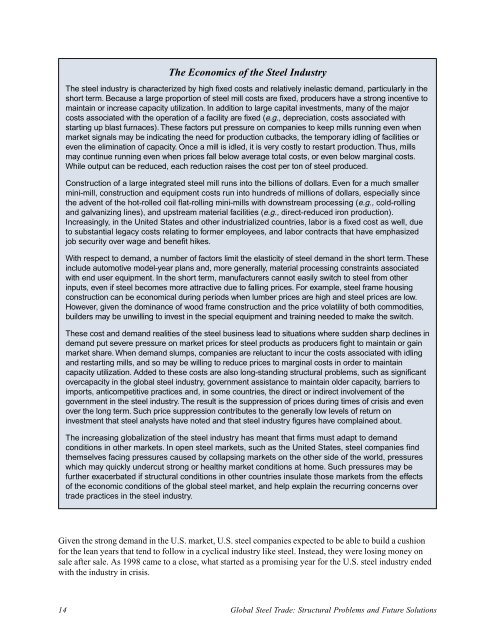Global Steel Trade; Structural Problems and Future Solutions
Global Steel Trade; Structural Problems and Future Solutions
Global Steel Trade; Structural Problems and Future Solutions
You also want an ePaper? Increase the reach of your titles
YUMPU automatically turns print PDFs into web optimized ePapers that Google loves.
The Economics of the <strong>Steel</strong> Industry<br />
The steel industry is characterized by high fixed costs <strong>and</strong> relatively inelastic dem<strong>and</strong>, particularly in the<br />
short term. Because a large proportion of steel mill costs are fixed, producers have a strong incentive to<br />
maintain or increase capacity utilization. In addition to large capital investments, many of the major<br />
costs associated with the operation of a facility are fixed (e.g., depreciation, costs associated with<br />
starting up blast furnaces). These factors put pressure on companies to keep mills running even when<br />
market signals may be indicating the need for production cutbacks, the temporary idling of facilities or<br />
even the elimination of capacity. Once a mill is idled, it is very costly to restart production. Thus, mills<br />
may continue running even when prices fall below average total costs, or even below marginal costs.<br />
While output can be reduced, each reduction raises the cost per ton of steel produced.<br />
Construction of a large integrated steel mill runs into the billions of dollars. Even for a much smaller<br />
mini-mill, construction <strong>and</strong> equipment costs run into hundreds of millions of dollars, especially since<br />
the advent of the hot-rolled coil flat-rolling mini-mills with downstream processing (e.g., cold-rolling<br />
<strong>and</strong> galvanizing lines), <strong>and</strong> upstream material facilities (e.g., direct-reduced iron production).<br />
Increasingly, in the United States <strong>and</strong> other industrialized countries, labor is a fixed cost as well, due<br />
to substantial legacy costs relating to former employees, <strong>and</strong> labor contracts that have emphasized<br />
job security over wage <strong>and</strong> benefit hikes.<br />
With respect to dem<strong>and</strong>, a number of factors limit the elasticity of steel dem<strong>and</strong> in the short term. These<br />
include automotive model-year plans <strong>and</strong>, more generally, material processing constraints associated<br />
with end user equipment. In the short term, manufacturers cannot easily switch to steel from other<br />
inputs, even if steel becomes more attractive due to falling prices. For example, steel frame housing<br />
construction can be economical during periods when lumber prices are high <strong>and</strong> steel prices are low.<br />
However, given the dominance of wood frame construction <strong>and</strong> the price volatility of both commodities,<br />
builders may be unwilling to invest in the special equipment <strong>and</strong> training needed to make the switch.<br />
These cost <strong>and</strong> dem<strong>and</strong> realities of the steel business lead to situations where sudden sharp declines in<br />
dem<strong>and</strong> put severe pressure on market prices for steel products as producers fight to maintain or gain<br />
market share. When dem<strong>and</strong> slumps, companies are reluctant to incur the costs associated with idling<br />
<strong>and</strong> restarting mills, <strong>and</strong> so may be willing to reduce prices to marginal costs in order to maintain<br />
capacity utilization. Added to these costs are also long-st<strong>and</strong>ing structural problems, such as significant<br />
overcapacity in the global steel industry, government assistance to maintain older capacity, barriers to<br />
imports, anticompetitive practices <strong>and</strong>, in some countries, the direct or indirect involvement of the<br />
government in the steel industry. The result is the suppression of prices during times of crisis <strong>and</strong> even<br />
over the long term. Such price suppression contributes to the generally low levels of return on<br />
investment that steel analysts have noted <strong>and</strong> that steel industry figures have complained about.<br />
The increasing globalization of the steel industry has meant that firms must adapt to dem<strong>and</strong><br />
conditions in other markets. In open steel markets, such as the United States, steel companies find<br />
themselves facing pressures caused by collapsing markets on the other side of the world, pressures<br />
which may quickly undercut strong or healthy market conditions at home. Such pressures may be<br />
further exacerbated if structural conditions in other countries insulate those markets from the effects<br />
of the economic conditions of the global steel market, <strong>and</strong> help explain the recurring concerns over<br />
trade practices in the steel industry.<br />
Given the strong dem<strong>and</strong> in the U.S. market, U.S. steel companies expected to be able to build a cushion<br />
for the lean years that tend to follow in a cyclical industry like steel. Instead, they were losing money on<br />
sale after sale. As 1998 came to a close, what started as a promising year for the U.S. steel industry ended<br />
with the industry in crisis.<br />
14 <strong>Global</strong> <strong>Steel</strong> <strong>Trade</strong>: <strong>Structural</strong> <strong>Problems</strong> <strong>and</strong> <strong>Future</strong> <strong>Solutions</strong>
















